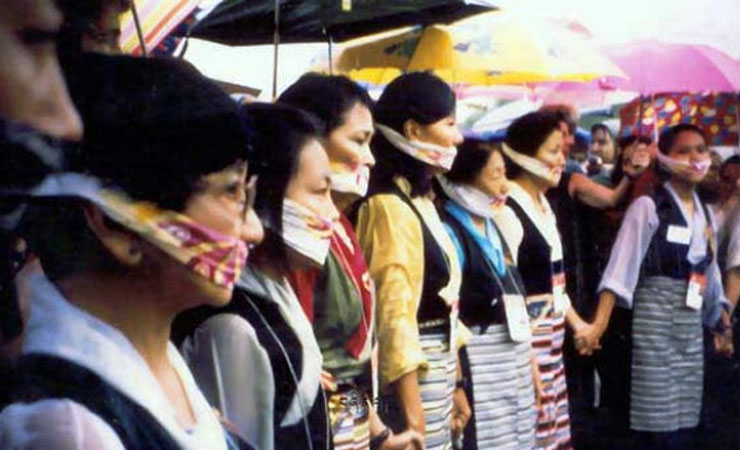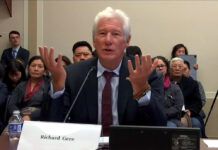By: Prof. Madhu Rajput* & Sqn Ldr Toolika Rani (retd)*
(TibetanReview.net, Jun23’20)
The air was sparse, the mountains high. Springing from the glaciers, the rivers sparkled like gems. The sound of flowing water was sometimes matched by the frenzied gusts of wind. Life echoed in the high plateau with mirth and laughter. There amidst these pristine surroundings, rode they on the horsebacks, the hardy Tibetan women, who behind their shy smiles hid the nerves of steel and a heart of tigress. Purity, serenity and peacefulness brought along with it an unsaid vulnerability. The hardships of day to day existence, of grazing the sheep, keeping warm, and tending to children were braved with a fortitude. At 4500 meters, their home wasn’t an ideally comfortable one but it was their own. The sense of connect with the rarified atmosphere, the feeling of belongingness with the soil was inexplicable. They had their roots there. And far from the rest of the world, in that considerable isolation in their high strung land, they moved freely on the vast pastures, on the icy slopes, chanting the Buddhist hymns of peace, non-violence, love and compassion.
However, the force of evil sometimes surpasses even the Force of Nature at times, though temporarily. In came the Red Dragon, trespassing and usurping their beloved land, committing all kinds of atrocities on these peace loving people, and driving them out of their homes- all to satiate its never ending greed for annexing territories. Life suddenly turned upside down. The certain, easy-moving rhythm of existence was abruptly and violently broken. Everything seemed bleak and dark. Suppression, violence, injustice overshadowed the exactly contrary values that they lived by. Was it then the victory of evil over the good? In that short moment- yes. But the judgements of the world, the rules of universe are not defined by moments. In the continuing battle, the initial victory/defeat cannot be considered the final. Thus, despite the unbearable agony of having to flee from their homes, they kept their faith in the good intact. In the flight for survival, all they brought along with them was ‘Hope’, hope for a better tomorrow, hope to return to their homes, hope for a peaceful existence. And this was the invisible but the strongest weapon they could have carried against their enemy. Combined with a strong will, it turned those ‘fragile females’ into unrelenting warriors, the bodies of whom could be broken by the cruel forces, but not the spirit! The spirit to protest, to stand up for their rights, to survive and not succumb, the spirit to keep the banner raised- years after years. And most astonishingly not by taking up arms, killing and adding to the same horrors of human degradation of inflicting pain and suffering on another human but by resilience, by insurmountable power of the right and the just, by negating and refusing to fulfil the vicious will of the annihilator to subsume them.
In occupied Tibet, none other than the nuns led the protest against annexation. Who could imagine that the hymn chanting women could be so fierce as to not bow down to the oppression and injustice, not even when the most inhuman physical pain was inflicted upon them. However powerful the oppressor, they didn’t let the cause of Tibet die. They kept the flame burning with their own lives. Those who escaped took upon themselves to keep the fight alive in their own distinct manner. The world is a mixture of good and bad. While one uprooted them, the other gave them shelter. India became the Tibetan’s second home. The disruption in their lives was enormous; a tragedy beyond imagination- shocking and numbing. The pain of being uprooted can only be understood by the one who has lost her home. More than a material loss, it is the loss of identity, of belongingness, of being flung out in the open with no anchor. New terrain, new people, different language, different culture, a climate totally different than theirs. With nothing in their possession, they started bare hands to build roads, to clear the hard land for cultivation, to sell, to cook. They adapted. The biggest survival tool that human beings can have is adaptation.
These women had not read in any book that humans had the amazing capacity to rebuild, that the world had faced two World Wars, and a major Economic Depression, and had still rebuilt. They had just observed the nature do so back there in their high plateau and that’s what they had imbibed. The instincts now kicked in naturally. And whenever the adversity became too tough to take, the words from their wise leader renewed that one thing they had carried- the Hope. Even when the dream seemed impossible, and the present circumstances eluded any possibility of attaining it, they kept the hope- of survival, revival and return to their homeland. It flung them into systematized action, with a purpose. They rebuilt their institutions, preserved their culture, cared for each other and carved their unique niche; of being the most organized refugee community in the world. Today their leader, His Holiness the Dalai Lama, is revered all over the world; they have been successful in keeping their fight alive, passing it onto their next generation which despite being born in exile, is equally sensitive and committed to the cause of Tibet.
The authors were amazed to hear Mr. Lobsang Sangay, The Prime Minister of Tibetan govt. in exile, when in the answer to our question in 2016, he very convincingly predicted a change in China and victory for Tibet. “Once we survive, we should strengthen through education, economy. As long as we strengthen ourselves, we can sustain. In next fifty years China will change. When China changes, we win, then basic freedom will be restored for Tibetans in Tibet. If they want to give autonomy, through dialogue it will happen. If they don’t want to give also, China will change, and automatically there will be a general autonomy for Tibetans. One way or the other, we will succeed”. This conviction in the face of a powerful enemy like China whose military, economic, geographical and all other scales weigh heavily against the tiny Tibet is wondrous and contagious. As students of History, we have seen the empires falling, the dictators being dethroned, the systems changing. It is the hope and sustained struggle and time that make it possible. As Buddhism reminds that nothing is permanent – the present state will change for sure. All one needs to do is to keep the efforts going in that tough phase and slowly move towards that change. The evil eventually blows itself up with its own intentions and actions. The way a strong anti-China sentiment is sweeping across the world in the wake of Covid-19, it may be the beginning of that change Mr. Sangay talked about. The saga of Tibetan survival is a lesson worth emulating by the humanity to overcome tragedies.
————
*Prof. Madhu Rajput is former Head of Department, Deptt. of Western History, University of Lucknow, India, and is the author of book, ‘Occupational Mobility in Exile- A Socioeconomic Study of Tibetan Women in Dharamshala and Dehradun’ (2019).
**Squadron Leader Toolika Rani is a retired Indian Air Force Officer and a research scholar in Ambedkar University, Lucknow, India. She can be reached at tulich83@gmail.com








